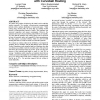Free Online Productivity Tools
i2Speak
i2Symbol
i2OCR
iTex2Img
iWeb2Print
iWeb2Shot
i2Type
iPdf2Split
iPdf2Merge
i2Bopomofo
i2Arabic
i2Style
i2Image
i2PDF
iLatex2Rtf
Sci2ools
MOBIHOC
2007
ACM
2007
ACM
Balancing traffic load in wireless networks with curveball routing
We address the problem of balancing the traffic load in multi-hop wireless networks. We consider a point-to-point communicating network with a uniform distribution of source-sink pairs. When routing along shortest paths, the nodes that are centrally located forward a disproportionate amount of traffic. This translates into increased congestion and energy consumption. However, the maximum load can be decreased if the packets follow curved paths. We show that the optimum such routing scheme can be expressed in terms of geometric optics and computed by linear programming. We then propose a practical solution, which we call Curveball Routing that achieves results not much worse than the optimum. We evaluate our solution at three levels of fidelity: a Java high-level simulator, the ns2 simulator, and the Intel Mirage Sensor Network Testbed. Simulation results using the high-level simulator show that our solution successfully avoids the crowded center of the network, and reduces the maximum...
| Added | 24 Dec 2009 |
| Updated | 24 Dec 2009 |
| Type | Conference |
| Year | 2007 |
| Where | MOBIHOC |
| Authors | Lucian Popa 0002, Afshin Rostamizadeh, Richard M. Karp, Christos H. Papadimitriou, Ion Stoica |
Comments (0)

